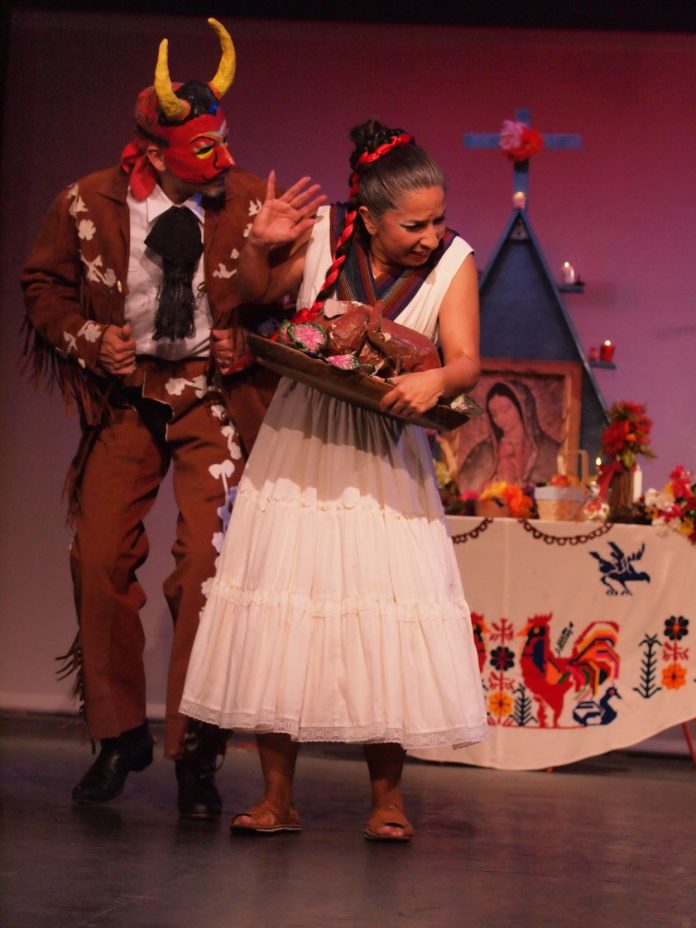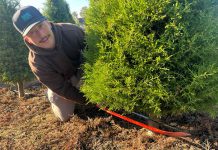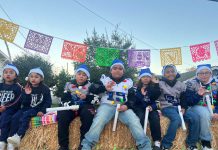
JoAnne Perez Robinson worked for five days in the heat painting the traffic box outside the Gilroy Center for the Arts. While she toiled away at the rich agricultural scene honoring local field workers, her dad, Raymond Perez, came each day carting along a picnic lunch and an umbrella to shield her from the Gilroy sun—sitting with her the entire time she painted.
But in March, just two weeks after Raymond celebrated his 70th wedding anniversary, he suddenly died. He was 88.
So when the Gilroy Center for the Arts approached Perez Robinson about creating a display for their annual Día de los Muertos exhibit, she says she thought it was a great opportunity and especially meaningful this year. “It turned out to be very therapeutic.”
Día de los Muertos, the Day of the Dead is originally an Aztec celebration of life dating back thousands of years and originating in present day Mexico. The celebration honors loved ones that have passed with prayers, festivals, gatherings and altars or offering tables (ofrendas). After Spanish conquerors settled in Mexico and unsuccessfully attempted to force the Aztecs to abandon their beliefs, the month-long summer festival was incorporated into Catholic observances of All Saints Day and All Souls Day held in the fall. Today the modern holiday of Día de los Muertos is observed throughout Latin America, as well as by other cultures around the world on Nov. 1 and 2. This year both Gilroy Center for the Arts in Gilroy and El Teatro Campesino in San Juan Bautista will be presenting community ofrendas for the public.
Kevin Heath, executive director of the Gilroy Center for the Arts, says this cultural exhibit is important to Gilroy. “I think it is a homage to one of the cultures that is here,” he says. “I know that within the culture there are a lot of altars in the home, and that is truly where the praying takes place. What we want to do is give an opportunity for them to come see other ideas and other altars. Not only are we respecting the cultural heritage of [the celebrations], we are also incorporating the art.”
This year marks the fifth annual Día de los Muertos exhibit at the Gilroy Center for the Arts. Sharon Albert, a Gilroy Arts Alliance board member, produces the event and has created several displays this year, including a very personal ofrenda honoring a fellow board member. Albert says they also created an altar honoring people who have brought importance to the culture, including Frida Kahlo and Diego Rivera, Jose Guadalupe Posada—the Mexican printmaker whose satirical illustrations of calaveras, the Spanish word for “skull,” prompted one of the most familiar symbols of Día de los Muertos, and Juan Gabriel—a Mexican entertainer, well-known for his showmanship, who passed away in August.
Albert says the displays offer the living “a way of expressing creativity and honoring those that have passed away, sending our love to them, and welcoming the spirit of that person back into our lives—not that they have really gone from our lives, but it is an extra special way of remembering them.”
Angelina Rojas, who has volunteered at both the Gilroy Center for the Arts and El Teatro Campesino, says after her father passed away 12 years ago, she immersed herself into the tradition and symbolism surrounding the celebration.
“I traveled to Mexico for the first time. I saw it and thought it was beautiful. I needed to know how it was celebrated. I wanted to know everything that was put on the altars and why.” Rojas explains that each of the items on an ofrenda, while not specific, should have a purpose.
“Salt purifies the spirit after they have traveled from dark and unpleasant areas. They have to come through that journey in darkness and with candles we give them light. We give them raw amber incense or copal oro—it sweetens the air and helps them find their way. Marigolds or cempasúchilare also very pungent and will also help them find their way.”
Rojas says that ofrendas traditionally incorporate the four elements—air, earth, fire and water—as well as the cardinal directions north, south, east and west.
“We honor the north with earth and with food—gravity gives us nourishments. The east is honored with the wind—it gives us movement and the Spirit comes in as the wind. The west is water—water is formless, it is passion, it is motion. The water cleans, purifies and quenches the thirst. In the south we have fire. Fire is an energetic force. You feel that when they arrive or when they are there. The fire gives us energy and strong will, as well as light.”
Many spend months gathering items to present on their ofrendas. Along with photos of those being honored and items representing the four elements, ofrendas traditionally include personal mementos of activities and foods that they loved.
This year Michelle Gonzalez created her second display at the Gilroy Center honoring her mother, great grandmother and maternal grandfather. She is representing wind with elaborately designed tissue paper (papel picado) that will move in the breeze, and water with a filled vessel (jarros) to help hydrate her loved ones after their journey. The jarros, a traditional Mexican pottery, were handed down from her great-grandmother to her mother, to her. “I feel like that is a way of still connecting with my mom,” Gonzalez says.
Perez Robinson, who has previously presented fine art shows at the center, describes creating her display. “I brought more than I could fit on the table, I had to edit it down.” She is symbolizing fire with a lantern from her father’s trailer, and air with a helium balloon of his favorite baseball team, the Giants. Along with items symbolizing the activities he enjoyed, she also incorporated foods he loved with root beer, See’s Candies and a can of chili.
El Teatro Campesino has hosted annual Día de los Muertos celebrations for 12 years with community altar displays inside the playhouse’s main lobby, including one that celebrates the lives of El Teatro members who have passed. Cristal Gonzalez is directing and producing the celebration for the second year alongside fellow producer Alfredo Avila. “It’s an acknowledgment of our loved ones that have left us throughout the years,” Gonzalez says.
“It is a spiritual celebration of our ancestors, and an opportunity for community members that do not know what Día de los Muertos is, to experience it in a very lively way through dance, through scenes that reflect on our ancestors, and really, an acknowledgement of where we come from and where we are going.”
El Teatro’s celebration is a multifaceted event including live music and dance performances by folkloric dance group Esperanza del Valle, community altar exhibits and a free theatrical piece presented as a street procession, Journey Through Mictlan, an original adaptation of the myth of the Aztec Underworld.
Last year the procession, which begins at the playhouse, grew to 400 viewers by the time it concluded, says Gonzalez.
People are encouraged to bring a picture of someone they would like to honor to add to the community altar.
“We need this time to acknowledge our past and our culture,” says Gonzalez. “There are not a lot of places within our small town to practice our culture, and this is one of the traditions that is still alive. Journey Through Mictlan explores the dead and the living and how we come together. Are we really ever apart, or are we navigating parallel to each other? Are we among the dead, or are the dead among us?”
SAN JUAN BAUTISTA:
El Teatro Campesino presents Día de los Muertos featuring Esperanza Del Valle. Community displays will be available for viewing prior to each performance. Layered clothing is recommended for the FREE street procession,Journey Through Mictlan. Tickets range from $12-22. Performances run Nov. 4 to Nov. 6. at 705 Fourth St, San Juan Bautista. For event times and more information, go to elteatrocampesino.com or call (831) 623-2444.
GILROY:
Gilroy Center for the Arts presents Día de los Muertos: 5th annual Exhibit and Altars. Viewing available on Tuesdays and Wednesdays from 2 p.m. to 5 p.m. and Saturdays and Sundays from 11 a.m. to 2 p.m. Showing now through Nov. 6. at 7341 Monterey St, Gilroy. For more information go to gilroyartsalliance.com or call (408) 842-6999.
Are we really ever apart, or are we navigating parallel to each other? Are we among the dead, or are the dead among us?









